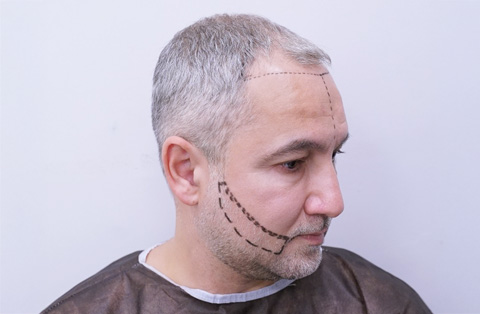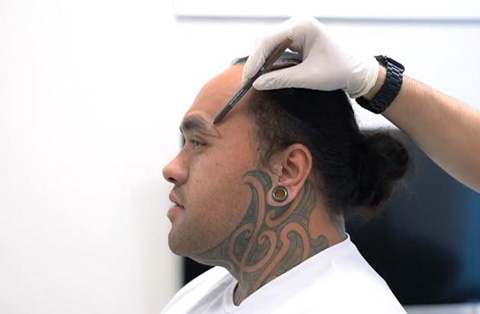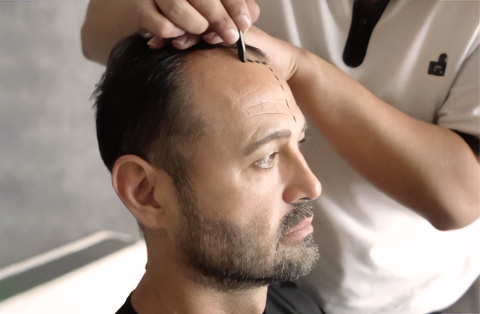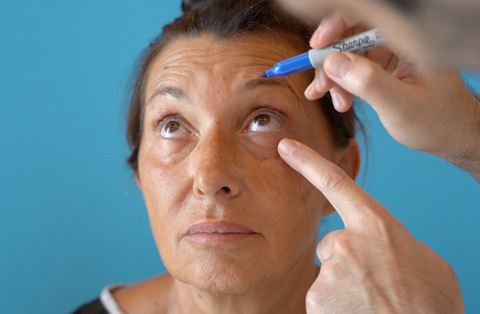Struggling with hair loss? Discover the common types, causes, and proven treatments that stop shedding and restore confidence. Learn how expert care can help you regain healthier, fuller hair.
Hair loss is the gradual or sudden loss of hair from the scalp or body. It can be temporary or permanent, and it affects people of all ages and backgrounds.
Hair loss is more common than many think. Up to 50 percent of men and women will experience noticeable hair thinning by the age of 50. It can affect self-esteem and signal underlying health conditions.
In this article, we’ll explore the most common types of hair loss, their causes, symptoms, diagnosis methods, and treatment options. You’ll also learn how to prevent hair loss and when to seek medical help.
What are the Common Types of Hair Loss?
Hair loss can happen for different reasons. It can affect only your scalp or your whole body. Some types are temporary. Others are permanent. Knowing the type of hair loss is the first step to choosing the right treatment.
Here are the most common types:
Androgenetic Alopecia
Androgenetic Alopecia is the most common cause of hair loss in both men and women. It is also called male pattern baldness or female pattern hair loss, depending on who it affects. This condition is genetically inherited and linked to hormones, especially dihydrotestosterone (DHT).
How It Happens
Hair grows in cycles. In androgenetic alopecia, the growth phase of the hair becomes shorter. The hair follicle shrinks. Over time, the hair becomes thinner and shorter. Eventually, the follicle stops producing hair.
In Men
Hair loss usually starts from the temples and crown in mail pattern hair loss. This creates an “M”-shaped hairline. It can progress over time and lead to complete baldness in some areas. This pattern is often predictable.
In Women
Hair loss tends to be more diffuse. There is a general thinning of the hair, especially on the top and crown. The hairline usually stays intact. Complete baldness is rare in women type hair loss.
What Causes It
Genetics: Family history plays a major role.
Hormones: DHT affects hair follicles and shortens the hair growth cycle.
Age: It becomes more common as you get older.
Diagnosis
Dermatologists can often diagnose it by looking at the pattern of hair loss. A scalp exam and medical history help confirm the diagnosis. In some cases, a scalp biopsy may be needed.
Treatment Options
The condition is progressive but treatable. Early treatment gives better results. Common options include:
Minoxidil (topical solution): Slows hair loss and may stimulate new growth.
Finasteride (oral medication): Blocks DHT in men.
Hair transplant surgery: Moves healthy hair follicles to thinning areas.
Low-level laser therapy: May help stimulate hair growth in some cases.
Is It Safe to Treat?
Yes, treatments for androgenetic alopecia are mostly safe. However, side effects are possible depending on the treatment method. For example, finasteride can cause sexual side effects in men. Minoxidil can irritate the scalp in some users. Hair transplant surgery has its own risks like infection or scarring, but it is generally safe when performed by experienced doctors.
This type of hair loss does not usually signal a deeper health issue. But it can affect self-esteem. Treating it early can improve both appearance and confidence. Hair transplantation for women has different features than for men.
Telogen Effluvium
Telogen Effluvium is a common type of temporary hair loss. It happens when a large number of hair follicles enter the telogen phase, or resting phase, of the hair cycle at the same time. Normally, only about 10% of your hair is in this phase. In telogen effluvium, this number increases significantly. As a result, more hair falls out than usual.
What Triggers It
This type of hair loss often starts two to three months after a major stress on the body or mind. Common triggers include:
High fever or severe illness
Surgery or major injury
Childbirth
Rapid weight loss or poor diet
Severe emotional stress
Certain medications (like antidepressants or blood pressure drugs)
Hormonal changes (like stopping birth control pills)
Thyroid disorders or iron deficiency
Symptoms
Hair usually sheds evenly across the scalp. You may notice more hair on your pillow, in the shower, or when brushing. The hairline usually stays the same. It rarely causes complete baldness.
Duration
In most cases, it is temporary. Hair shedding slows down after the body recovers from the stress. Hair starts to grow back within 3 to 6 months. Full recovery may take up to a year.
Diagnosis
Doctors often diagnose telogen effluvium based on your medical history and a physical exam. Sometimes, blood tests are done to rule out other causes like thyroid problems or low iron.
Treatment
The key is to identify and treat the underlying cause. If it's a one-time event, no specific treatment may be needed. In some cases, doctors may recommend:
Nutritional supplements (like iron, zinc, or vitamin D)
Stress management techniques
Gentle hair care
Topical minoxidil (to support hair regrowth)
Is It Serious?
Telogen effluvium is not a dangerous condition. It does not cause permanent damage to the hair follicles. Most people fully recover. But it can be emotionally distressing, especially when large amounts of hair are lost.
Early support and reassurance can make a big difference. If hair loss lasts longer than 6 months, it may become chronic telogen effluvium or may suggest another type of hair loss, which needs further evaluation.
Alopecia Areata
Alopecia Areata is an autoimmune condition. It causes the body’s immune system to attack its own hair follicles. As a result, hair falls out in small, round patches. It can affect the scalp, eyebrows, eyelashes, beard, or any other part of the body. Learn more about how to stop alopecia areata from spreading.
What Causes It
The exact cause is not fully understood. It is believed to be a mix of genetics and environmental triggers. If you have a family history of autoimmune diseases, your risk is higher. Common triggers include:
Severe emotional or physical stress
Viral infections
Other autoimmune disorders like thyroid disease or vitiligo
Types of Alopecia Areata
Patchy alopecia areata: Small, round patches of hair loss on the scalp or body
Alopecia totalis: Loss of all hair on the scalp
Alopecia universalis: Complete loss of hair on the body, including eyebrows and eyelashes
Ophiasis pattern: Hair loss around the sides and lower back of the scalp
Symptoms
The main sign is sudden hair loss in smooth, round patches. The skin in these areas looks normal. It is not red, scaly, or itchy. In some cases, nails may also show pitting or ridges.
Hair may regrow on its own. But new patches can appear. The course of the disease is unpredictable. Some people recover fully. Others may experience repeated cycles of hair loss and regrowth.
Diagnosis
A doctor can usually diagnose alopecia areata by looking at the pattern of hair loss. Sometimes, a scalp biopsy is done to confirm the diagnosis. Blood tests may help identify related autoimmune conditions.
Treatment
There is no cure, but several treatments may help hair regrow:
Corticosteroid injections: Reduce inflammation around hair follicles
Topical corticosteroids: For mild cases
Topical immunotherapy: Triggers an allergic reaction to restart hair growth
Minoxidil: May support regrowth
JAK inhibitors: A newer class of drugs that show promising results, especially in severe cases
Is It Dangerous?
Alopecia areata is not life-threatening. It does not cause physical pain. But it can deeply affect emotional well-being. Some people may develop anxiety or depression because of the visible changes in appearance.
This condition is not contagious. It does not damage the skin permanently. With the right support and treatment, many patients see improvement over time.
Traction Alopecia
Traction Alopecia is a type of hair loss caused by repeated tension or pulling on the hair over a long period. It is common among people who often wear tight hairstyles, such as ponytails, braids, buns, or extensions.
How It Happens
Hair follicles are sensitive to constant pulling. When the hair is under regular stress, it weakens the follicles. Over time, this can lead to inflammation and damage. If not addressed early, the hair loss can become permanent.
Who Is at Risk
Individuals who wear tight hairstyles every day
People who use hair extensions, wigs, or weaves with glue or tight clips
Athletes who wear tight headgear (like helmets or swim caps)
Children whose hair is styled too tightly
People who straighten or chemically treat their hair often
Symptoms
Thinning hair, especially around the hairline, temples, or behind the ears
Redness, bumps, or soreness on the scalp
Broken hairs of different lengths in affected areas
In advanced cases, shiny or scarred areas where hair no longer grows
Diagnosis
A doctor usually diagnoses it by examining the scalp and asking about hair care habits. No special tests are needed in most cases.
Treatment
The most effective treatment is to remove the source of tension. In early stages, hair can regrow once the pulling stops. Treatment options include:
Changing to looser hairstyles
Avoiding chemical treatments or heat styling
Using gentle hair care products
Applying topical minoxidil in some cases to support regrowth
In severe cases with scarring, hair transplant surgery may be an option
Is It Serious?
Traction alopecia is not dangerous. But if ignored, it can lead to permanent hair loss. The key is early detection and stopping the harmful hair practices. With the right care, most people can prevent further damage and even regrow some of the lost hair.
Cicatricial Alopecia
Cicatricial Alopecia, also known as scarring alopecia, is a rare but serious form of hair loss. It happens when inflammation destroys the hair follicles and replaces them with scar tissue. Unlike other types of hair loss, this one causes permanent damage. Once the follicle is destroyed, hair cannot grow back.
What Causes It
The exact cause is not always clear. It can be linked to several skin or autoimmune conditions. These include:
Lichen planopilaris
Frontal fibrosing alopecia
Discoid lupus erythematosus
Central centrifugal cicatricial alopecia (CCCA)
Sometimes, it may also follow infections, burns, or severe scalp injuries.
Symptoms
Patches of hair loss with smooth, shiny skin
Redness, swelling, or scaling on the scalp
Itching, burning, or pain
Pus-filled bumps in some cases
Hair loss that spreads over time
These symptoms vary based on the cause and how active the disease is.
Diagnosis
Diagnosis usually requires a scalp biopsy. This helps to see what type of inflammation is present and if there is scarring around the follicles. Blood tests or other exams may also be used to find any related autoimmune disease.
Treatment
The goal is to stop the inflammation before more hair is lost. Since the damage is permanent, early treatment is important. Options include:
Topical or injected corticosteroids
Oral anti-inflammatory drugs (like hydroxychloroquine or antibiotics)
Immunosuppressive medications
Antibiotics (for infection-related cases)
Hair transplant surgery may be considered later, but only if the disease is no longer active.
Is It Dangerous?
Cicatricial alopecia is not life-threatening. But it can be emotionally distressing and physically uncomfortable. It requires close monitoring by a dermatologist. Because the hair loss is permanent, early diagnosis and treatment are key to protecting the remaining hair.
Causes of Hair Loss
Hair loss can happen for many reasons. Sometimes it is due to genetics. Other times it is triggered by health conditions, lifestyle, or external factors. Understanding the cause is important. It helps to choose the right treatment and prevent further loss.
Genetic Factors
Hereditary hair loss is the most common cause. It is known as androgenetic alopecia. It affects both men and women. The hair follicles become sensitive to a hormone called DHT. Over time, hair becomes thinner and stops growing.
Hormonal Changes
Hormones affect the hair growth cycle. Sudden changes can lead to hair shedding. This is common in:
Pregnancy and childbirth
Menopause
Thyroid disorders
Discontinuing birth control pills
Medical Conditions
Several health issues can lead to hair loss:
Alopecia areata: An autoimmune condition
Lupus or other autoimmune diseases
Scalp infections like ringworm
Anemia due to low iron
Chronic illnesses like diabetes
Nutritional Deficiencies
Hair needs vitamins, minerals, and protein to grow. Deficiencies in:
Iron
Zinc
Vitamin D
Protein
can all lead to thinning hair. Learn more about the vitamin deficiencies causes hair loss.
Stress and Lifestyle Factors
Severe emotional or physical stress can push more hairs into the resting phase. This condition is called telogen effluvium. Hair loss often starts 2 to 3 months after the stressful event.
Tight hairstyles, harsh treatments, and frequent use of heat tools can damage the hair and scalp. Over time, this may cause traction alopecia or breakage.
Symptoms of Hair Loss
The symptoms of hair loss vary depending on its type and cause. Some people notice a gradual thinning. Others may lose hair suddenly. Hair loss can affect the scalp or the whole body. Early detection helps manage the condition better.
Common Hair Loss Symptoms
Gradual Thinning on Top of the Head
This is the most common sign of hair loss. It often starts with a receding hairline in men or overall thinning in women, especially at the crown.Patchy or Circular Bald Spots
This is typical in conditions like alopecia areata. The scalp or beard may show smooth, round patches without hair.Sudden Hair Shedding
Hair may fall out quickly, especially after stress, illness, or childbirth. You may notice more hair on your pillow, in the shower, or when brushing.Thinning Along Hairline or Temples
In traction alopecia, hair loss often begins where the hair is pulled the most—near the forehead or around the ears.Full-Body Hair Loss
Some medical treatments, such as chemotherapy, can cause hair to fall out from all over the body, including eyebrows and eyelashes.Scalp Redness or Irritation
In scarring alopecia, hair loss may be accompanied by symptoms like redness, itching, burning, or swelling of the scalp.Short, Broken Hairs
This may point to hair shaft damage due to styling or external stress. It often happens with harsh treatments or heat exposure.Scalp Scaling or Pus
If there’s an infection, the scalp may be flaky, painful, or have pus-filled bumps. This can cause temporary or permanent hair loss if untreated.
If you notice these symptoms, especially if they worsen over time, seeking medical advice early can help protect your hair and health.
Diagnosis of Hair Loss
Diagnosing hair loss starts with identifying the cause. A detailed medical history, scalp exam, and sometimes lab tests help your doctor understand what is going on. The right diagnosis leads to the most effective treatment.
Step-by-Step Diagnosis
1. Medical History
Your doctor will ask about:
When the hair loss began
Any recent illness, stress, or life changes
Family history of hair loss
Hair care habits
Medications or supplements
Changes in diet or weight
This helps rule out common triggers like stress, hormonal shifts, or drug side effects.
2. Physical Examination
A close look at the scalp gives important clues:
Pattern of hair loss (diffuse or patchy)
Condition of the scalp (redness, scaling, inflammation)
Signs of scarring or infection
Hair shaft health and breakage
3. Pull Test
The doctor gently pulls a group of hairs to see how many come out. This helps check if too many hairs are in the resting (telogen) phase.
4. Tug Test
This checks the strength of the hair strand itself. It helps identify if the hair is breaking rather than falling out at the root.
5. Scalp Biopsy
In unclear or severe cases, a small skin sample is taken from the scalp. A microscope shows if there is inflammation or scarring around the follicles. It also helps diagnose types like cicatricial alopecia or alopecia areata.
6. Blood Tests
These may be done to check for:
Iron levels (to rule out anemia)
Thyroid function
Vitamin D, zinc, and other nutrients
Autoimmune or hormonal conditions
Each test helps narrow down the cause. Some types of hair loss, like androgenetic alopecia, are diagnosed mainly by pattern and history. Others need more tests to confirm.
Getting the correct diagnosis early improves your chances of successful treatment. It also helps avoid wasting time on treatments that may not work for your condition.
Hair Loss Treatment Options
Hair loss treatments depend on the cause, type, and severity of the condition. Some options aim to slow hair loss. Others help stimulate regrowth or restore hair through surgical methods. Early treatment often gives better results.
Medications
Minoxidil (Topical Solution or Foam)
Used for both men and women
Slows hair loss and may promote regrowth
Applied directly to the scalp
Needs to be used continuously to maintain results
Finasteride (Oral Medication)
Approved for men only
Reduces levels of DHT, a hormone linked to hair loss
Helps slow thinning and may promote new growth
Not suitable for women, especially during pregnancy
Spironolactone
Sometimes prescribed for women with hormonal hair loss
Works by blocking androgen effects on hair follicles
Hair Transplant Surgery
Involves moving hair follicles from a healthy area to a balding area
Two main methods: FUE (Follicular Unit Extraction) and FUT (Follicular Unit Transplantation)
Best for androgenetic alopecia
Results are natural-looking and permanent
Related Articles:
Lifestyle Changes
Reducing stress
Avoiding tight hairstyles and harsh treatments
Using gentle hair care products
Alternative Therapies
Low-Level Laser Therapy (LLLT)
Uses light to stimulate hair follicles
May improve hair thickness and slow loss
Suitable for early stages of genetic hair loss
Platelet-Rich Plasma (PRP) Therapy
Uses your own blood to extract growth factors
Injected into the scalp to support hair regrowth
Often used alongside other treatments
Nutritional Support
Supplements like iron, zinc, biotin, and vitamin D help if levels are low
A balanced diet supports healthy hair
Topical or Injectable Steroids
Used in alopecia areata and some inflammatory scalp conditions
Reduce inflammation and support regrowth
Immunotherapy and JAK Inhibitors
For more severe cases of alopecia areata
May be used when other treatments fail
Newer options with promising results, especially for widespread hair loss
Safety and Effectiveness of treatments for hair loss
Most treatments are safe when used properly. Medications may have side effects, such as scalp irritation or hormonal effects. Surgical and injection-based treatments require trained professionals to reduce risks like infection or scarring.
Choosing the right treatment depends on your diagnosis, age, expectations, and overall health. A personalized plan often gives the best outcome.
How to Prevent Hair Loss
Preventing hair loss is not always possible, especially when it is caused by genetics or certain medical conditions. But many types of hair loss can be slowed or avoided with the right care and habits. Early action is key to preserving hair health.
Be Gentle with Your Hair
Avoid tight hairstyles like ponytails, braids, or buns that pull on the roots
Use a wide-tooth comb to reduce breakage
Limit heat styling (flat irons, curling irons, blow dryers)
Avoid harsh chemical treatments like bleaching or frequent coloring
Wash and Care Properly
Use a mild shampoo suited to your hair type
Avoid overwashing, which can strip natural oils
Massage your scalp gently to improve blood flow
Let your hair air-dry when possible
Eat a Balanced Diet
Include protein-rich foods like fish, eggs, and legumes
Ensure enough iron, zinc, and vitamin D
Stay hydrated to support overall scalp health
Consider supplements only if a deficiency is confirmed
Manage Stress
Practice relaxation techniques like yoga, meditation, or deep breathing
Get regular sleep and maintain a routine
Seek professional help if stress or anxiety is severe
Treat Underlying Health Issues
Manage conditions like thyroid disease or anemia
Follow up with your doctor if you notice any scalp changes or excessive shedding
Keep chronic illnesses under control with regular check-ups
Protect Your Scalp
Wear a hat or use sunscreen when exposed to the sun
Avoid scalp injuries or repeated friction (such as from headwear)
Avoid Self-Medication
Do not use over-the-counter hair loss products without proper diagnosis
Some products may worsen the problem or cause side effects
Preventive care works best when it starts early. If you notice changes in your hair volume, density, or shedding pattern, getting professional advice helps protect your hair before the damage becomes permanent.
Frequently Asked Questions
How do I identify my type of hair loss?
Look at the pattern and speed of your hair loss. Check if it's patchy, diffuse, or along the hairline. Notice any itching, redness, or scaling. A doctor can confirm the type through scalp exam, medical history, and sometimes a biopsy or blood test. Early diagnosis improves treatment results.
How much hair loss is normal?
Losing 50 to 100 hairs per day is normal. This is part of the natural hair growth cycle. If you notice sudden shedding, thinning, or bald spots, it may be a sign of hair loss. In such cases, consult a doctor to check for underlying causes or early treatment needs.
Is losing 200 hairs a day normal?
Losing 200 hairs a day is not normal for most people. It may suggest telogen effluvium, stress, or other health issues. If the shedding continues for more than a few weeks, or if you see thinning areas, it’s important to see a doctor for diagnosis and appropriate treatment.
How many new hairs grow a day?
On average, your scalp grows about 80 to 100 new hairs each day. This matches the normal daily shedding. Hair grows in cycles, so not all follicles produce hair at the same time. If hair loss outpaces regrowth, you may start noticing thinning or bald spots.
Can you thicken your hair?
Yes, in many cases, you can thicken your hair. Treatments like minoxidil, PRP therapy, and proper nutrition help. Avoid heat, tight styles, and harsh products. If hair thinning is due to health issues, treating the root cause supports regrowth. Results take time and vary by individual.
Do all types of chemo cause hair loss?
No, not all chemotherapy drugs cause hair loss. Some drugs only cause thinning, while others lead to full hair loss. It depends on the type, dose, and treatment plan. Hair usually grows back after treatment ends. Your doctor can explain what to expect based on your specific medication.





